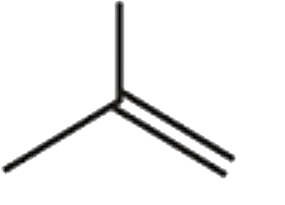What is the major product alkene formed in the following elimination?




The correct Answer is:A
To determine the major product alkene formed from the given elimination reaction, we will follow these steps:
Step 1: Identify the Structure
The given structure is a nitrogen-containing compound with multiple alkyl groups attached to the nitrogen atom. The nitrogen has a positive charge (N^+), indicating it is likely a quaternary ammonium salt.
Step 2: Understand the Elimination Reaction
This elimination is known as the Hofmann elimination, which typically involves the removal of an alkyl group from a quaternary ammonium salt to form an alkene. The nitrogen atom will lose one of its alkyl groups, leading to the formation of a double bond in the resulting alkene.
Step 3: Determine the Alkyl Groups
In the provided structure, we have several alkyl groups attached to the nitrogen. We need to identify which alkyl group will be eliminated. The most stable alkene will be formed by eliminating the least sterically hindered alkyl group, which is usually the one that leads to the most substituted double bond.
Step 4: Elimination of the Alkyl Group
When we eliminate one of the alkyl groups, we will form a double bond between the adjacent carbon atoms. Given that the nitrogen has multiple methyl (CH₃) groups and other carbon chains, we will focus on the carbon chain that leads to the most substituted alkene.
Step 5: Draw the Major Product
After the elimination of the appropriate alkyl group, we will draw the resulting alkene. The major product will be the most stable alkene, which is typically the one with the most substituents on the double bond.
Conclusion
The major product alkene formed from this elimination reaction is:
- CH₂=CH-CH(CH₃)-CH₃ (which can also be represented as 2-butene).
Final Answer
The major product alkene formed from the elimination is 2-butene.
---
The given structure is a nitrogen-containing compound with multiple alkyl groups attached to the nitrogen atom. The nitrogen has a positive charge (N^+), indicating it is likely a quaternary ammonium salt.
This elimination is known as the Hofmann elimination, which typically involves the removal of an alkyl group from a quaternary ammonium salt to form an alkene. The nitrogen atom will lose one of its alkyl groups, leading to the formation of a double bond in the resulting alkene.
In the provided structure, we have several alkyl groups attached to the nitrogen. We need to identify which alkyl group will be eliminated. The most stable alkene will be formed by eliminating the least sterically hindered alkyl group, which is usually the one that leads to the most substituted double bond.
When we eliminate one of the alkyl groups, we will form a double bond between the adjacent carbon atoms. Given that the nitrogen has multiple methyl (CH₃) groups and other carbon chains, we will focus on the carbon chain that leads to the most substituted alkene.
After the elimination of the appropriate alkyl group, we will draw the resulting alkene. The major product will be the most stable alkene, which is typically the one with the most substituents on the double bond.
The major product alkene formed from this elimination reaction is:
- CH₂=CH-CH(CH₃)-CH₃ (which can also be represented as 2-butene).
The major product alkene formed from the elimination is 2-butene.
Similar Questions
Knowledge Check
The major product formed in the following reaction is
CH3−CH3∣C∣H−CH2BrCH3O−−−−−→CH3OHACH3−CH3∣C∣H−CH2OCH3BCH3−CH∣OCH3−CH2CH3CCH3−CH3∣C=CH2DCH3−CH3∣C∣OCH3−CH3CH3−CH2−O∣∣C−CH3∣C∣CH3−CH3PhCO3H−−−−−→A,A will be
ACH3−CH2−O−O∣∣C−CH3∣C∣∣CH3−CH3BCH3−CH2−O∣∣C−O−CH3∣C∣CH3−CH3CCH3−CH2−O∣∣C−CH3∣−∣CH3O−CH3DNone of these⎛⎜ ⎜⎝−−CH2−CH3∣C∣CH3−CH2−CH3∣C∣CH3−−⎞⎟ ⎟⎠n is a polymer having monomer units.
A B
B C
C D
D
CH3−CH3∣C∣CH3−CH=CH−CH3H−Cl−−−→ ?
View SolutionGive the IUPAC names of the following compounds :CH3CH3−CH3∣C∣CHO−CH2CH3
View SolutionGive the IUPAC names of the following compounds :CH3CH3−CH3∣C∣CHO−CH2CH3
View SolutionGive the IUPAC name of the compound
CH3−CH3∣C∣CH3−CH2−CH2−CH2−CH3∣C∣CH3−CH3
View SolutionWhat would be the major products in the following reactions:
CH3−CH3∣C∣CH3−CH2BrC2H5OH−−−−→Δ
View Solution
